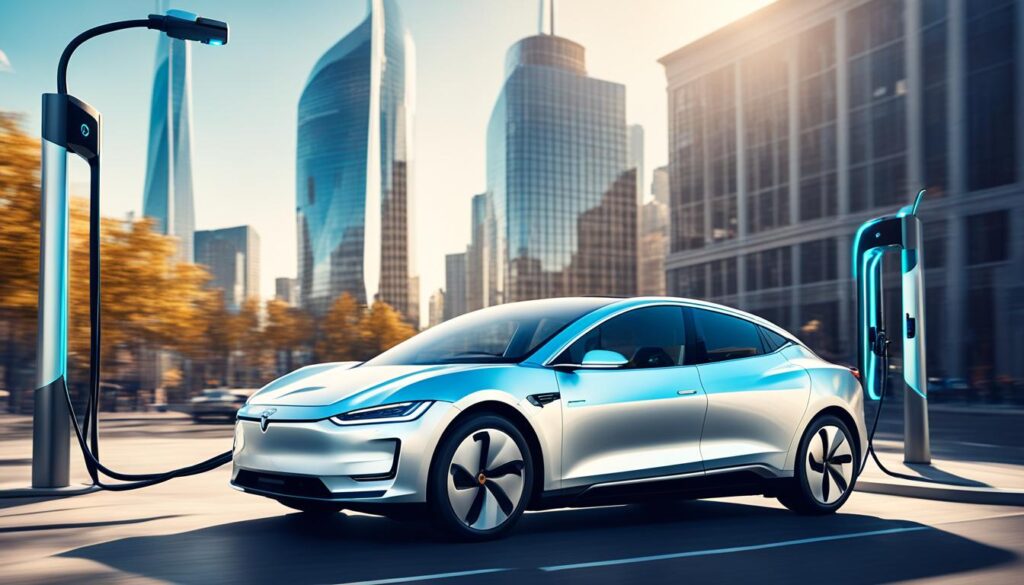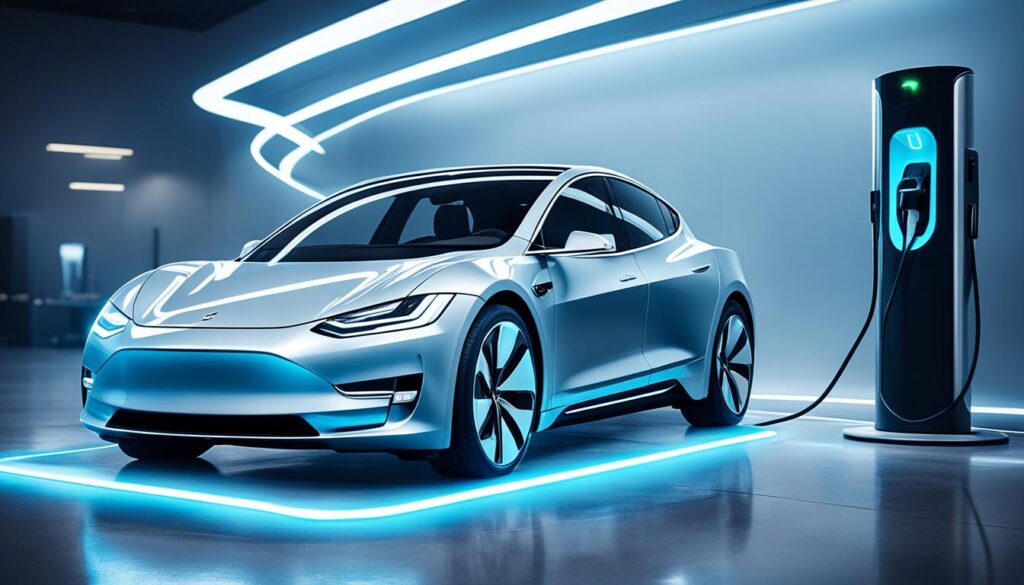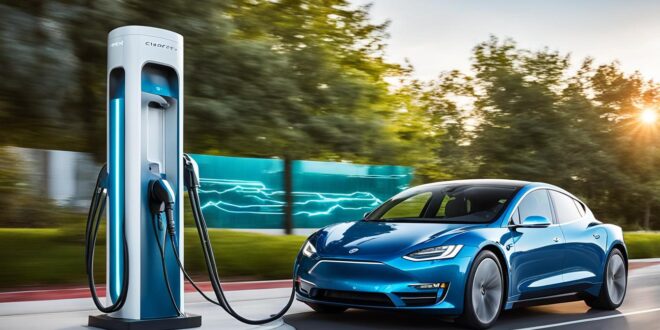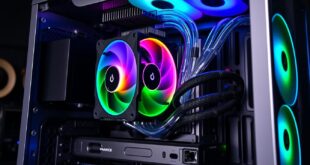The rise of electric vehicles (EVs) has changed the car world. But, many drivers still wonder: how long does it take to charge an EV? The good news is, charging EVs is getting faster and more efficient every year.
Some EV models can now charge up to 200 miles in just 20 minutes1. This big improvement is making more people switch to EVs. It’s solving a big problem for drivers.
We’ll look at the fastest ways to charge your electric car. We’ll talk about rapid charging, the different charging levels, and the latest in charging tech and infrastructure. This article will help you charge your car faster and get back on the road quickly.
Key Takeaways
- Rapid charging can add hundreds of miles of range in just 20 minutes
- Understanding the different charging levels and their speeds is crucial for efficient charging
- Locating and using high-powered DC fast chargers can significantly reduce charging times
- Optimizing your vehicle’s battery management and charging infrastructure can further enhance charging speeds
- The future of EV charging is promising, with advancements in technology and the expansion of charging networks
Rapid Charging: Accessing High-Powered EV Charging Stations
The use of electric vehicles (EVs) is growing fast. This means we need quick and reliable ways to charge them. Rapid charging is a big step forward, letting EV owners charge their cars quickly and easily2.
Understanding Charging Levels and Speeds
EVs charge at different levels, from slow Level 1 to fast Level 3, also known as DC fast charging. Level 1 and 2 chargers are usually found at homes and public spots. But DC fast chargers are special, giving a quick boost to an EV’s battery2.
Locating and Using DC Fast Chargers
Now, EV owners can find more DC fast charging stations everywhere. These stations are often by highways and in key spots, offering quick charging. To use them, just find the nearest station, park, and start charging with your car’s system or a charging app2.
| Charging Level | Typical Power Output | Charging Time for 200 miles |
|---|---|---|
| Level 1 (120V) | 1.4 – 1.9 kW | 50+ hours |
| Level 2 (240V) | 3.3 – 19.2 kW | 4 – 10 hours |
| DC Fast Charging | 50 – 350 kW | 15 – 45 minutes |
Knowing about charging levels and finding DC fast chargers makes EV travel easy. It makes long trips and daily drives smoother and worry-free2.

How can I charge my electric car the fastest?
As more people switch to electric vehicles (EVs), charging them quickly and efficiently is a big concern. Luckily, new tech in battery management and charging is making it easier. Here are some tips to charge your EV fast.
Optimizing Charging Times with Battery Management
Managing your battery well is key to quick charging. EVs now have smart battery systems that help charge faster. By knowing how your car’s battery works, you can cut down charging time3.
Advancements in Charging Technology and Infrastructure
New tech and more charging spots are changing the game for EV drivers. Fast DC chargers are popping up, filling up your battery quickly4. Plus, more public chargers and smart charging solutions make finding a spot easier.
Keep up with the latest in battery and charging tech to make charging better. The future of EV charging is always improving, so keep an eye out for new updates.

3Fire and Rescue NSW dealt with 54 e-scooter, e-bike, e-skateboard, and hoverboard fires in NSW, with two deaths in one year34. In 2018, EV charging stations made USD 3.8 billion in sales4. The market grew by 52.4% in 2022, hitting US$ 19.5 billion4.
Preparing Your Vehicle for Optimal Charging Speeds
To charge your electric car quickly, you need to prepare it right. Follow a few easy steps to make charging faster and more efficient.
First, make sure your car’s battery is in top shape. Keep it cool and avoid overcharging to keep it running well for a long time5. Also, check the battery’s health often to spot any problems early5.
- Maintain your vehicle’s battery health through proper care and charging practices.
- Regularly check the battery’s state of health to identify any potential issues.
Next, use the latest charging tech. Many electric cars can fast charge, cutting down charging time5. Fast charging can save you minutes at the station5.
- Leverage the fast-charging capabilities of your electric vehicle to reduce charging times.
- Seek out and use high-powered DC fast charging stations whenever possible.
Think about the weather and your driving when charging. Temperature and your usual driving distance affect charging efficiency6. Adjust these to make charging faster and spend less time at the station6.
“Preparing your electric vehicle for optimal charging speeds is a crucial step in maximizing the convenience and efficiency of your driving experience.”
A well-prepared electric car charges faster, getting you back on the road quicker6. Follow these tips for quicker charging and a smoother electric drive6.
Optimizing Charging Times with Battery Management
Good battery management helps with faster charging. Companies like Porsche are working on better batteries and charging7. These improvements mean quicker charging for electric car owners7.
| Metric | Improvement |
|---|---|
| Battery Energy Density | 12% more energy density |
| Charging Speed | Up to 320kW DC fast charging |
| Charging Time | 315km of range in 10 minutes |
By using the latest in charging tech and managing your battery well, you can charge faster. This makes driving more convenient and efficient7.
Embracing the Future of Efficient EV Charging
Looking ahead, the future of electric vehicles (EVs) is bright thanks to new charging tech and infrastructure8. GaN (Gallium Nitride) semiconductors are changing the game with their fast speeds, high power, and efficiency8. This tech is making charging faster, more reliable, and fits well in tight spaces, which is great for our planet and for saving space.
Standardized certifications8 and better manufacturing methods8 are key to making GaN charging common. As GaN costs go down8, we’ll see more charging spots, making EVs easier for everyone8. GaN is also making renewable energy and LED lights better8, showing its big impact on energy use.
GaN semiconductors8 will play a big part in the Industrial Internet of Things (IIoT) and edge computing8. They help process data fast and make smart choices in industries. With GaN leading the way, we’re on track for a future where charging is easy and EVs are key to a greener world.
FAQ
What are the fastest ways to charge my electric car?
How do I locate and use DC fast charging stations?
How can I optimize my electric car’s charging times?
What can I do to prepare my vehicle for optimal charging speeds?
How is the charging infrastructure evolving to support faster EV charging?
Source Links
- https://www.thisismoney.co.uk/money/holidays/article-13710643/Can-money-package-holiday-cancelled-does-ATOL-protection-mean.html – What are your rights if your package holiday is cancelled?
- https://www.carwow.co.uk/news/4678/most-and-least-reliable-car-brands-revealed – Driver Power survey reveals most and least reliable car brands
- https://www.theepochtimes.com/world/lithium-battery-e-bikes-face-tough-new-standards-after-54-fires-5701827 – Lithium Battery E-Bikes Face Tough New Standards After 54 Fires
- https://www.fmiblog.com/2024/08/08/explosive-growth-in-the-ev-charging-station-market-projected-to-reach-usd-122-8-billion-by-2033-with-a-cagr-of-18-3-fmi-reports/ – EV Charging Station Market Share, Size 2033
- https://www.drive.com.au/reviews/2024-jeep-avenger-review-international-first-drive/ – 2024 Jeep Avenger review: International first drive
- https://www.trendhunter.com/trends/battery-swap – Battery Swap Initiatives
- https://www.carexpert.com.au/car-reviews/2024-porsche-taycan-review-2 – 2025 Porsche Taycan review
- https://www.bisinfotech.com/gallium-nitride-gan-semiconductors-boosting-power-efficiency-in-industrial-automation/ – Gallium Nitride (GaN) Semiconductors: Efficiency in Industrial Automation
 Gmrxe Entertainment and Information
Gmrxe Entertainment and Information




